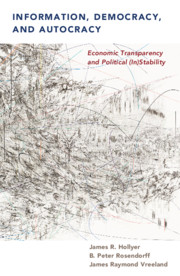Information, Democracy, and Autocracy
Advocates for economic development often call for greater transparency. But what does transparency really mean? What are its consequences? This breakthrough book demonstrates how information impacts major political phenomena, including mass protest, the survival of dictatorships, democratic stability, as well as economic performance. The book introduces a new measure of a specific facet of transparency: the dissemination of economic data. Analysis shows that democracies make economic data more available than do similarly developed autocracies. Transparency attracts investment and makes democracies more resilient to breakdown. But transparency has a dubious consequence under autocracy: political instability. Mass-unrest becomes more likely, and transparency can facilitate democratic transition - but most often a new despotic regime displaces the old. Autocratic leaders may also turn these threats to their advantage, using the risk of mass-unrest that transparency portends to unify the ruling elite. Policy-makers must recognize the trade-offs transparency entails.
- Constructs an objective measure of government transparency that has consistent meaning over time and extensive coverage
- Can be used by scholars interested in a variety of phenomena from political accountability to mass protest to market movements
- Treating missing data 'as data', can help explain key phenomena of interest in political science
- Makes advanced political science more accessible to a wider range of scholars, graduate students, and undergraduates
Reviews & endorsements
'Information, Democracy, and Autocracy provides a novel theoretical approach to leveraging meaningful data out of strategically missing data …' Steven Lloyd Wilson, Perspectives on Politics
Product details
September 2018Hardback
9781108420723
396 pages
236 × 158 × 26 mm
0.67kg
Available
Table of Contents
- 1. A new approach to the study of transparency
- 2. The content of information
- 3. The HRV index of transparency
- 4. Comparing measures of transparency
- 5. Transparency and (in)stability – the theory
- 6. The evidence – examples and descriptive data
- 7. The evidence – regression analyses
- 8. Transparency and investment
- 9. Why democracies disseminate more data than autocracies
- 10. Why autocrats disclose
- 11. Consequences of transparency
- References
- Index.





